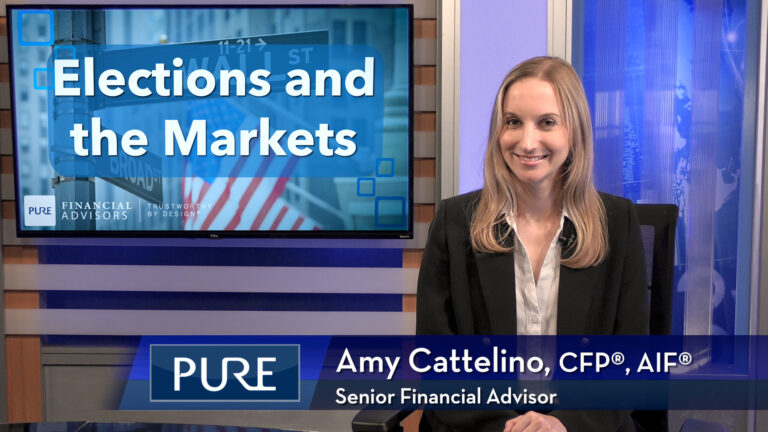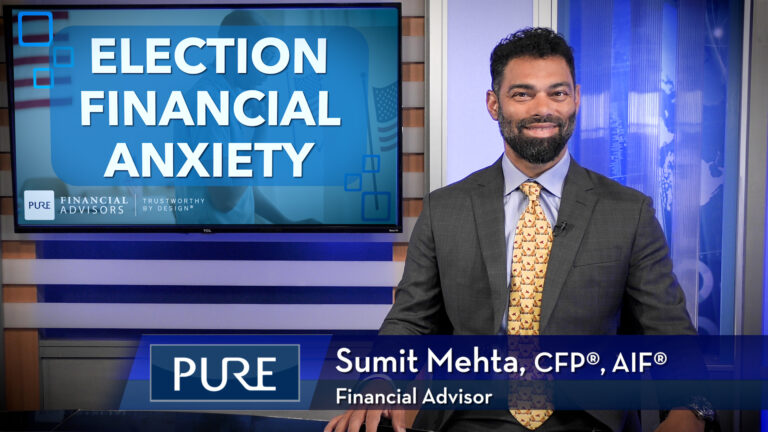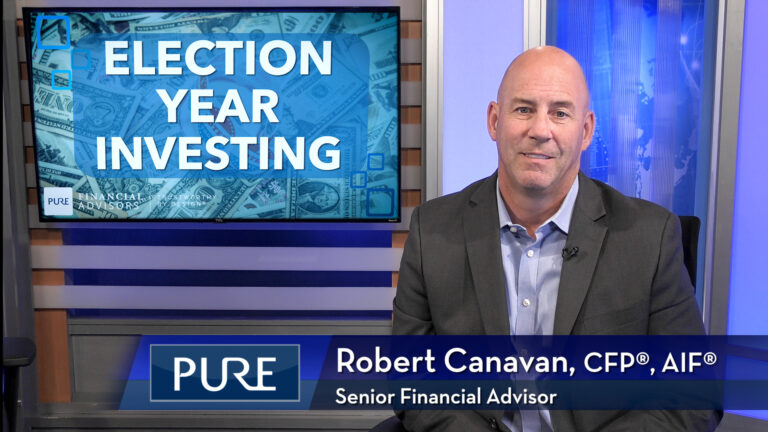Give yourself peace of mind and fund your passions while staying on track to meet long-term goals through charitable giving strategies. Pure’s Financial Planner, Brian Wolff, CFP®, AIF®, explains five tax-efficient and impactful strategies that can help your retirement plan while giving back to your community:
- Select the right asset to give
- When rebalancing a portfolio, consider donating appreciated positions
- Divest privately held interests via a donor advised fund
- Elect charitable contributions to offset a high-income year
- If doing a Roth conversion, offset the increased taxable income with a charitable contribution
FREE GUIDE | Tax Smart Charitable Giving Guide
Transcript
With everything that’s going on in the world today, many people feel confused, frustrated, or simply exhausted. Amid all this chaos, you may be reflecting on how your current personal finances align with your long-term goals. While having wealth can mean a high standard of living, it can also help bolster a legacy, both family oriented and community based. Charitable giving allows you to support the issues you care about while impacting the world around you, and with the ongoing uncertainty in our economy, it’s important to look at charitable giving strategies intelligently. The following are five tax-efficient and impactful charitable giving strategies for you to consider to help give your wealth more meaning.
#1 Select the right asset to give
Even with current markets being more volatile, many investors find themselves with appreciated assets due to the almost unprecedented bull run between 2009 and 2020. By donating long-term appreciated stock to charity, including charities that sponsor a donor-advised fund program, you may enhance your charitable tax deduction and make a more significant impact than selling the stock first and then donating the after-tax proceeds. You may also avoid a higher capital gains tax rate and the additional 3.8% Medicare surtax that you would have otherwise incurred by selling the stock. What about cash? Investors may believe that cash is the right asset to donate in any given year, but cash donations often have a lower tax efficiency and may reduce the amount of the donation going to the charity. Many times, donating appreciated assets can be more advantageous than donating cash, however it’s always a good idea to discuss which makes the most sense for you with a financial advisor.
#2 When rebalancing a portfolio, consider donating appreciated positions
During periodic reviews of your portfolio, you may find that it has become increasingly exposed to additional risk from appreciation or has simply fallen out of alignment with your goals. Instead of selling the appreciated positions to rebalance, consider making a charitable gift of the long-term appreciated asset through a donor advised fund. By doing so, you may be eligible to take a tax deduction for the fair market value of the asset and potentially eliminate the capital gains tax and Medicare surtax.
#3 Divest privately held interests via a donor advised fund
For investors with a non-publicly traded interest, such as a family-owned business, donating a portion, or all, of the interest to charity before divestiture can yield substantial tax benefits over a private foundation. It may allow for a tax deduction for the current fair market value of the donated assets, rather than the original cost basis, which is what a private foundation would use. When using a donor advised fund, this approach can greatly simplify complex transactions, and support multiple charities with a single asset.
A donor advised fund provides a simplified approach to supporting the charities of your choice, while potentially maximizing charitable contributions and tax benefits. By establishing a donor advised fund, you can support multiple charities with a single contribution, and are eligible for an immediate tax deduction. You can give stocks, mutual funds, cryptocurrency, or non-publicly traded assets, which other charities may not be able to accept, and you can choose from several investment options for your donations as they wait to be distributed. It streamlines your recordkeeping and consolidates tax receipts, while creating a valuable estate planning tool to support your legacy goals.
#4 Elect charitable contributions to offset a high-income year
If you’ve had a particularly high-income year, giving to a donor advised fund may reduce your taxable income and possibly keep you from going into a higher tax bracket. This should be considered when there is a unique event, such as a financial windfall, or a work bonus that’s not anticipated to repeat annually. In these years, consider a “bunching” strategy to your donor advised fund. This allows you to frontload multiple years’ worth of charitable giving into the current year. Doing this may allow you to surpass the itemization threshold and take a larger deduction in the year of the gift, then use the standard deduction in the following years.
#5 If doing a Roth conversion, offset the increased taxable income with a charitable contribution
The power of the Roth IRA is that it allows you to set aside after-tax income that grows tax-free for life. Many investors may utilize Roth conversions to reposition their tax-deferred dollars to a Roth IRA to take advantage of this type of growth. However, converting tax-deferred IRA dollars to a Roth IRA triggers a taxable event. In years where conversions are recommended you should consider making a charitable gift in the same tax year to offset some, or all, of the taxable income generated from the conversion. Consider the “bunching” strategy mentioned before to accelerate multiple years’ gifts into the same year. This may allow for a larger conversion with potentially less tax burden.
These are just a few of the strategies. If you’d like to explore in-depth how charitable giving can benefit your retirement plan while helping others, take advantage of our free financial assessment.
Subscribe to our YouTube channel.
IMPORTANT DISCLOSURES:
• Investment Advisory and Financial Planning Services are offered through Pure Financial Advisors, LLC, a Registered Investment Advisor.
• Pure Financial Advisors LLC does not offer tax or legal advice. Consult with your tax advisor or attorney regarding specific situations.
• Opinions expressed are subject to change without notice and are not intended as investment advice or to predict future performance.
• Investing involves risk including the potential loss of principal. No investment strategy can guarantee a profit or protect against loss in periods of declining values.
• All information is believed to be from reliable sources; however, we make no representation as to its completeness or accuracy.
• Intended for educational purposes only and are not intended as individualized advice or a guarantee that you will achieve a desired result. Before implementing any strategies discussed you should consult your tax and financial advisors.
CFP® – The CERTIFIED FINANCIAL PLANNER™ certification is by the Certified Financial Planner Board of Standards, Inc. To attain the right to use the CFP® designation, an individual must satisfactorily fulfill education, experience and ethics requirements as well as pass a comprehensive exam. Thirty hours of continuing education is required every two years to maintain the designation.
AIF® – Accredited Investment Fiduciary designation is administered by the Center for Fiduciary Studies fi360. To receive the AIF Designation, an individual must meet prerequisite criteria, complete a training program, and pass a comprehensive examination. Six hours of continuing education is required annually to maintain the designation.














